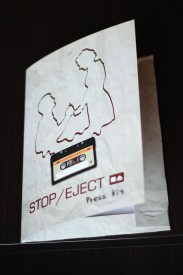
This week the lovely press kit folders for Stop/Eject arrived. Although we probably won’t need these for a while, you never know when something might come up; I wish I’d had one of these for the FilmWorks finale last month. The folders were designed by Alain Bossuyt of Le Plan B, who won the poster competition last summer, and printed by Sign Link Graphics.
For Soul Searcher I had the press kits printed as brochures. The disadvantage with this is that you have to reprint the whole thing if you want to make changes or add things, which might well happen as reviews come in and your festival run develops. With folders it will be easy to remove sheets and add new or revised ones.

So what will be on those sheets? What should a press kit contain?
First up you need a SYNOPSIS. For a feature film you should include a short one, similar to the blurb you’d get on the back of a DVD cover, and a longer one, somewhere between 500 and 1,000 words. If you read Sight & Sound magazine you’ll see that they reprint these synopses verbatim.
Then you need biographies of the key CAST AND CREW. Sometimes these are included as extras on vanilla DVD releases.
Next come the PRODUCTION NOTES – behind-the-scenes anecdotes about the origins and making of the film. In the early days of DVDs you could often find these reproduced like liner notes in a little leaflet inside the case.

Next you need a BONUS SECTION, for want of a better name. This is where you provide some extra material for a journalist to fill out their article with. Commonly this will be something related to the subject of the film. For example, the press kit for The Fast and the Furious might have included some facts and figures about illegal street racing. For Stop/Eject we might put in some info about cassette tapes and their history. For Soul Searcher I took a slightly different tack and included some extracts from my production diary.
Finally you need to include the complete CREDITS. Again, Sight & Sound reproduces these in full.
(If you’re supplying publicity photos on CD, which is unusual in these days of ubiquitous broadband, you shoud also include a sheet of thumbnails with accompanying filenames and photographer credits.)

Remember when you’re writing all this that you’re trying to give a journalist a story on a plate. You need to give them all the exciting elements they need to effortlessly put an interesting article together. The bonus section in particular gives you a chance to provide them with an angle – a hook which convinces them this is a story worth telling.
Why print all this, rather than emailing a PDF? Because a nice glossy folder on a journalist’s desk is more likely to get read than yet another attachment in the inbox. And if you meet someone unexpectedly at a festival or other event, it’s far better than to give them a hardcopy to take away than to rely on them reading an email you send later.